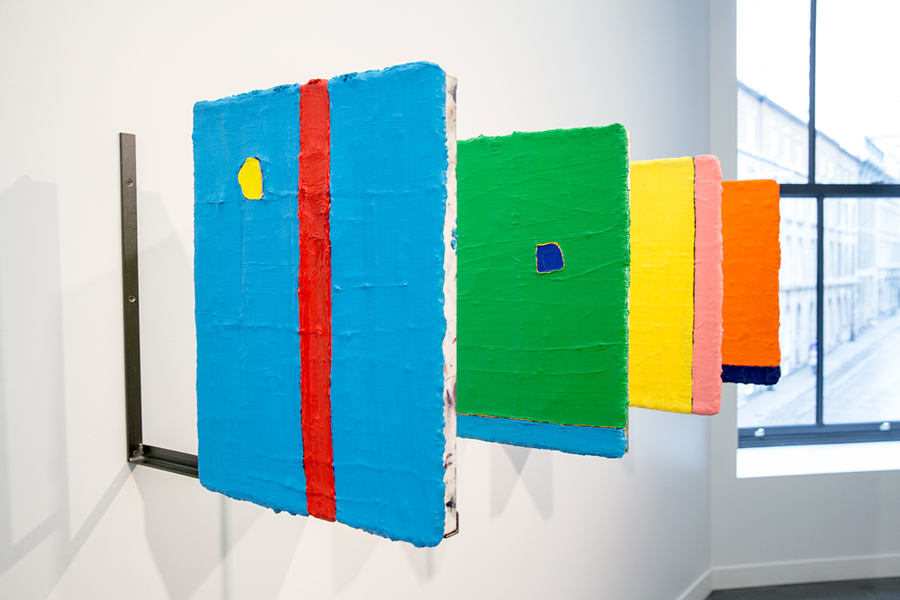As viewers walk up the stairs of the PHI Centre and into the brightly lit room, they are immediately faced with an odd collection of objects and materials, surrounded by colourful canvases. Living in a material world is an exhibition featuring the work of Montreal artists Paul Bureau and Valérie Kolakis. The contrast of the two artists’ styles makes their combined showing seem like a strange choice. Yet their art is linked by a celebration of the artist’s tools, whether those are as traditional as oil paint or as atypical as an iron bar.
The wall directly in front of the staircase has a mirror on it. An iron rope hanging from the ceiling divides the mirror in two. To the left, a stack of wooden chairs – similar to the ones you would find in your high school storage closet – is covered with a sheet of plastic, as if discarded. These cryptic and intriguing pieces are the works of Kolakis.
Turning the corner of the large column that occupies the centre of the room, viewers find themselves faced with Bureau’s paintings. Canvases are smothered in layer upon layer of oil paint, accumulating on their surface in peaks, slightly raised – like icing on a cake. With their bright, playful colours and textured surfaces, they command the viewer’s attention from the plain white wall. The contrast between Kolakis’ industrial-looking works and Bureau’s paintings is remarkable, yet these works have much more in common in their purpose than they do in aesthetics and appearance.
The key word here, as the title of the exhibit points out, is ‘material.’ Both artists strive to explore, discover, and play with their art’s medium in divergent approaches. Kolakis’ “Untitled (Rug)” is a set of different-sized, concrete-covered rugs rolled up and leaned against the wall, like Persian rugs in an overcrowded antique store. This atypical material highlights the necessity of texture in defining a specific object. Can we still call these rugs if they are covered in concrete and no longer pleasant to walk on? The viewer is able to hone in on the concrete’s rough surface, its light grey shade, and its rigidity.
Similarly, Bureau’s paintings disclose the nature of the material he uses. While Kolakis’ displayed works are monochromatic – a glass panel, the grey rugs, the black iron – Bureau’s are bursting with colour. Like Kolakis, Bureau’s works focus the viewer’s attention on the material itself, a materiality which in this case happens to occur in manifestations of colour. Four consecutive paintings are sliced through, front to back, to reveal each individual layer of paint, which together built up to the final façade of the piece. Yellows, blues, blacks, whites; all varieties of colours have oozed out of the canvases’ cracks and hardened. In almost every work displayed, Bureau makes the process of painting evident by making incisions, exposing the artistic labour otherwise masked by the final product.
Bureau explains that he sees art as something “labour-intensive” in which time is a factor. For him, the process is a mix of both “control” and “intuition and freedom.” This emphasis on process, and the straddling of choice and chance, can be found in Kolakis’ works as well. Her chairs are mass produced objects that she did not design herself. She has let something external to her creative process decide what her creation will consist of, yet as the artist she has assembled her work as she sees fit. United in method and purpose, Kolakis and Bureau glorify their media by bringing them to the forefront of their work.
Living in a material world is showing at the PHI Centre (407 St. Pierre) till September 28. Free admission.

